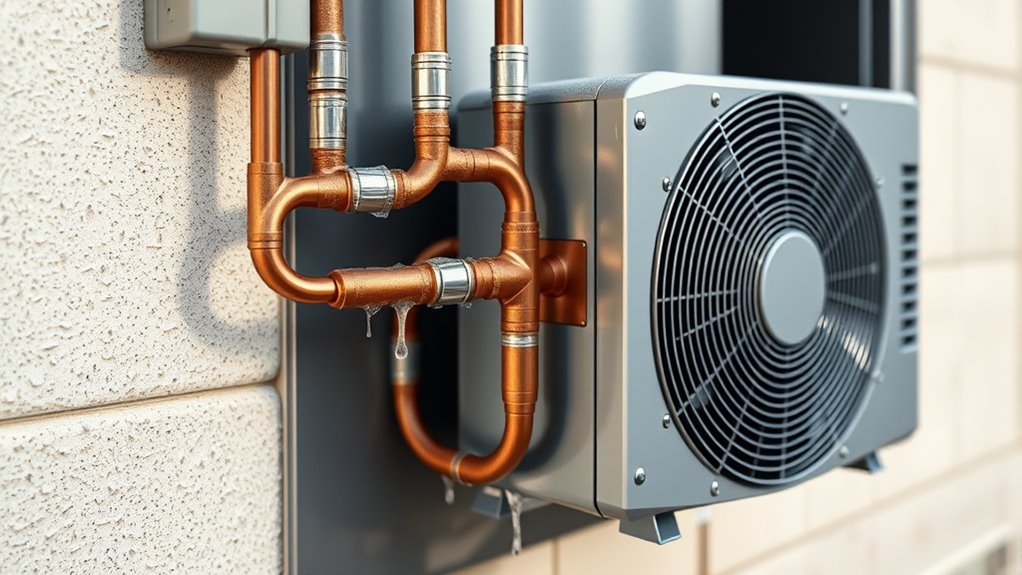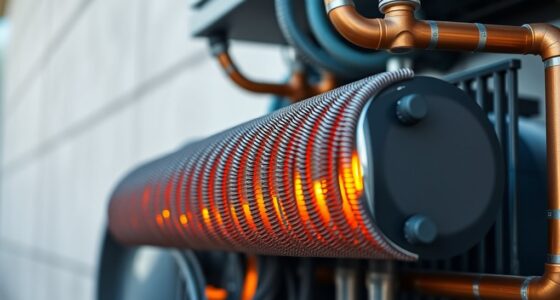Understanding thermal energy transfer in heat pump systems involves grasping how heat moves through conduction, convection, and radiation. You need to know how components like coils, compressors, and refrigerants work together to transfer heat efficiently. Factors like temperature differences, surface properties, and insulation play vital roles in performance. By exploring these principles, you’ll see how innovative materials and precise design optimize heating and cooling. Keep exploring to uncover more about maximizing system efficiency.
Key Takeaways
- Heat pumps transfer thermal energy by moving heat from an outside source to indoors using refrigerant cycles.
- Key mechanisms include conduction, convection, and radiation, each influenced by surface properties and temperature differences.
- Components like the compressor, evaporator, and condenser facilitate phase changes and refrigerant flow for efficient heat transfer.
- Enhancing heat transfer involves optimizing surface contact, insulation, and using advanced materials like nanofluids and PCMs.
- Temperature differentials drive heat flow; larger differences increase transfer rates, while insulation minimizes energy losses.
The Basics of Thermal Energy and Its Role in Heat Pumps
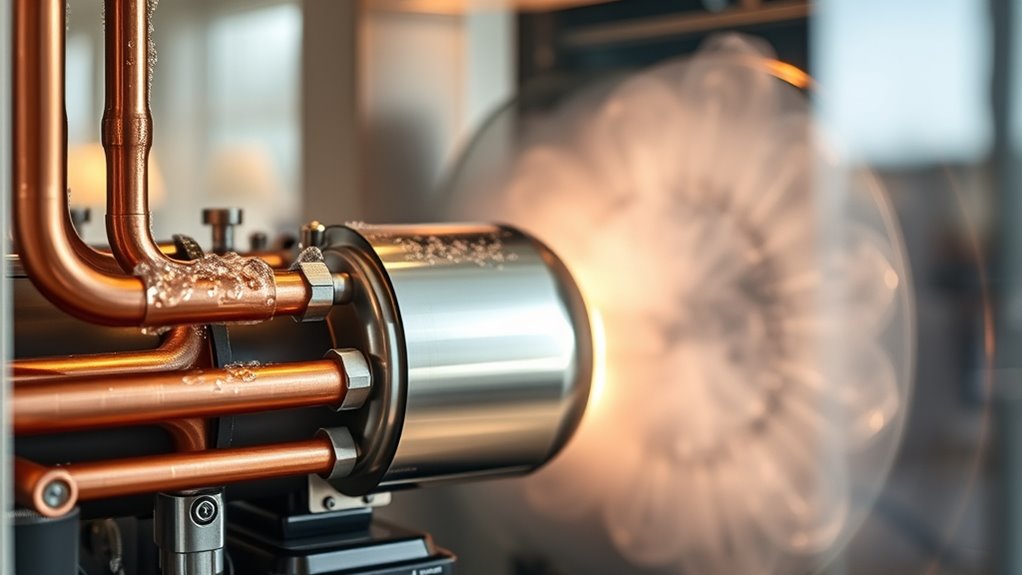
Thermal energy is the internal energy stored in matter, resulting from the movement of particles and the bonds between them. In heat pump systems, thermal energy plays a crucial role in heat transfer, moving heat energy from one place to another. When heat from outside is absorbed, it’s transferred into your indoor space through controlled heat exchange, enhancing energy efficiency. As particles in a hot object move faster, they transfer heat energy to cooler objects, making thermal energy transfer possible. Heat pump systems utilize this principle, extracting heat from outside air or ground and transferring it indoors. This process allows you to heat your home efficiently, even when the outside temperature is low. Understanding how thermal energy moves helps optimize heat transfer and improves the overall performance of heat pump systems. Efficient heat transfer is essential for maximizing the effectiveness of these systems and reducing energy consumption. Recognizing the role of thermal energy transfer can lead to better system design and operation, especially when considering system maintenance and proper installation practices. Additionally, advancements in refrigerant technology contribute to the overall efficiency and environmental sustainability of heat pump systems. Moreover, understanding the relationships in energy transfer fosters innovations that can further improve system performance and sustainability.
How Heat Is Transferred Through Conduction, Convection, and Radiation
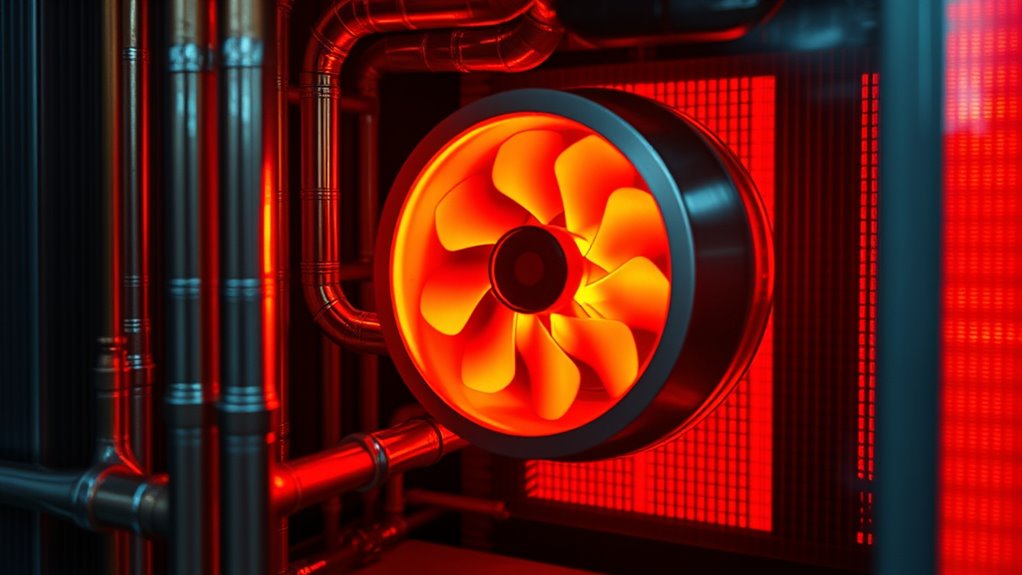
Understanding how heat moves through different materials helps you grasp how heat pumps work more effectively. Conduction transfers heat through direct contact, with metals like copper and aluminum having high thermal conductivity, allowing rapid heat transfer. Convection involves fluid circulation, where warm, less dense areas rise and cooler, denser regions sink, facilitating heat flow. Radiation transfers heat via electromagnetic waves, which can occur across vacuum spaces, with surface emissivity and temperature influencing radiant energy emission. The rate of heat transfer by conduction increases with larger temperature differences, better surface contact, and higher thermal conductivity. Additionally, the thermal properties of materials significantly impact their heat transfer efficiency. Each mechanism—conduction, convection, and radiation—dominates in different conditions, working together to transfer thermal energy efficiently within heat pump systems. Recognizing the different heat transfer mechanisms is essential for optimizing heat pump performance and ensuring energy-efficient operation.
The Design and Components of a Heat Pump System

A heat pump system functions through a series of interconnected components that work together to transfer heat efficiently. Refrigerant lines connect key parts, carrying refrigerant between the outdoor coil, indoor coil, compressor, and other components. The compressor pressurizes the refrigerant, increasing its temperature for effective heat transfer. The reversing valve switches the system between heating and cooling modes by reversing refrigerant flow. The heat exchanger, consisting of the evaporator coil and condenser coil, absorbs and releases heat respectively. During heating, the outdoor coil acts as an evaporator, while the indoor coil serves as a condenser. The expansion valve regulates refrigerant flow into the coils. Together, these components form a closed loop that efficiently moves heat, providing indoor comfort regardless of outdoor temperatures. Additionally, high efficiency in heat pump systems relies on optimal component design and proper refrigerant charge to maximize energy savings. Modern advancements in refrigerant technology contribute significantly to system performance and environmental sustainability. Ensuring proper maintenance of refrigerant levels is essential for sustained efficiency and system longevity, which can be achieved through regular professional inspections and servicing. Regular monitoring of system pressures helps detect potential issues before they impact performance.
The Thermodynamic Principles Underpinning Heat Pump Operation
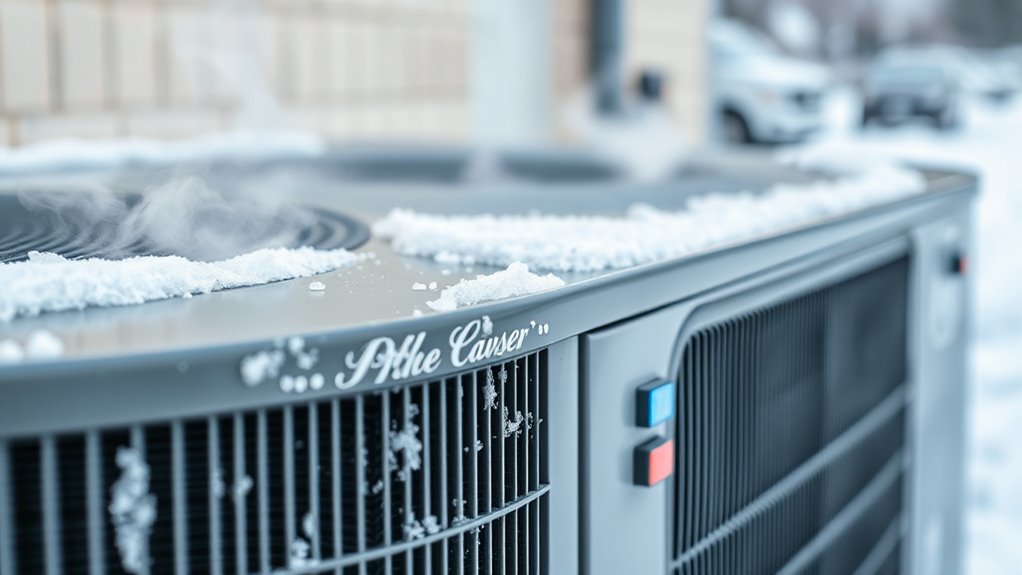
The operation of a heat pump is rooted in fundamental thermodynamic principles that govern how heat energy moves and transforms. You harness thermodynamics to transfer heat against natural flow, using work input. The heat cycle relies on phase changes of the refrigerant—evaporation and condensation—to enable efficient heat transfer. Energy conservation laws ensure no energy is lost, just transformed, while entropy increases as heat moves from hot to cold areas. The refrigerant’s cycle demonstrates how work input drives heat transfer, improving efficiency. Additionally, understanding heat flow is essential for optimizing system performance and energy savings. Proper management of thermodynamic processes is crucial in designing systems that maximize energy efficiency and sustainability. Recognizing the importance of heat transfer mechanisms helps in enhancing system design and operational effectiveness. Moreover, analyzing energy transfer pathways allows engineers to identify potential improvements in heat pump systems for better energy utilization.
Practical Applications of Heat Transfer in Heating and Cooling
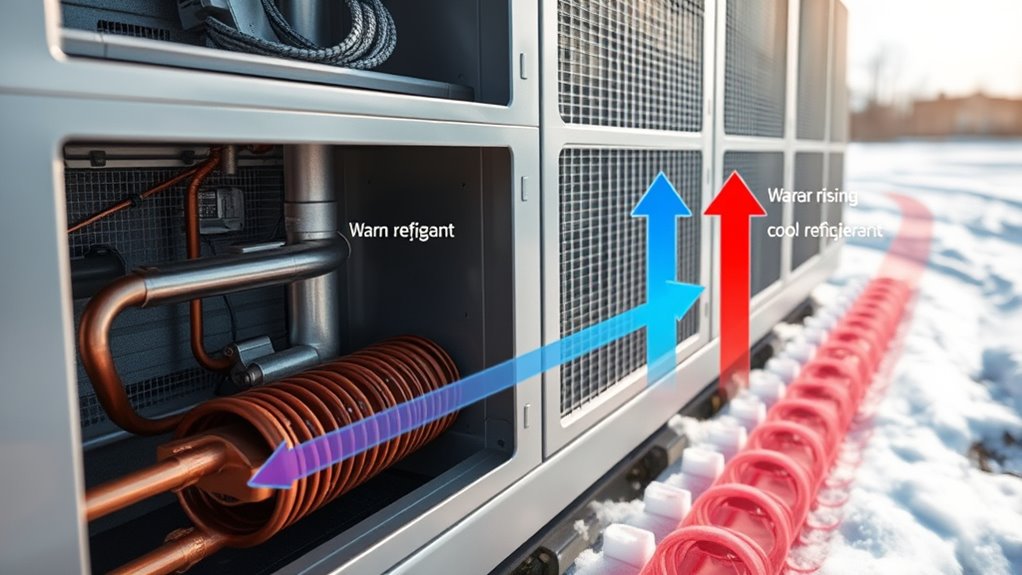
Heat transfer methods such as conduction, convection, and radiation play a key role in everyday heating and cooling systems. In a heat pump cycle, refrigerant absorbs thermal energy through evaporation involving conduction and convection, then releases it during condensation. To optimize efficiency, consider these practical applications:
Heat transfer methods optimize heat pump efficiency through conduction, convection, and radiation.
- Using heat exchangers to transfer thermal energy between refrigerant and air or water without direct contact.
- Selecting insulation materials to minimize conduction and convection losses, improving overall energy efficiency.
- Designing surface properties like emissivity to enhance radiant heat transfer in radiators or panels.
- Managing refrigerant flow to maximize heat transfer during both heating and cooling cycles.
Additionally, understanding the types of heat transfer involved can help in designing more effective systems. Recognizing how heat transfer mechanisms interact in different environments allows engineers to develop tailored solutions for each application. For example, optimizing the thermal conductivity of materials can significantly impact system performance. Moreover, considering the material properties involved in heat transfer can aid in selecting appropriate components to improve efficiency. A comprehensive understanding of heat transfer principles enables the development of more energy-efficient and reliable heating and cooling solutions.
Factors That Influence Thermal Energy Movement and Efficiency

Your understanding of thermal energy transfer depends on several key factors. Larger temperature differences speed up heat flow, while the quality of system insulation can either boost or hinder efficiency. Recognizing how these elements interact helps optimize heat movement in various applications. Additionally, the layering and detailing of surfaces can influence how effectively heat is transferred, affecting overall system performance. Proper tuning of heat pump components can further enhance transfer efficiency and system longevity. Implementing lifestyle strategies such as maintaining a comfortable indoor temperature can also contribute to the system’s effectiveness. Understanding the best heat transfer methods can guide more efficient system design and operation. Being aware of prohibited transactions ensures compliance with regulations and protects your investment in heat pump systems.
Temperature Differentials
Ever wonder why some objects transfer energy faster than others? It all depends on the temperature differential. When the temperature difference between two surfaces or environments is greater, heat transfer accelerates. This is because a larger temperature gradient boosts the flow of thermal energy through:
- Heat conduction — direct transfer through solids.
- Heat convection — movement of fluids like air or water.
- Heat radiation — emission of infrared energy.
- Maintaining a significant temperature differential maximizes heat pump efficiency. Additionally, the drivetrain components of a bike can influence energy transfer efficiency by affecting overall system performance. If the temperature difference shrinks, heat transfer slows, reducing system effectiveness. Environmental factors like airflow, humidity, and surface properties can also influence how quickly thermal energy moves. To optimize heat transfer, ensure a sufficient temperature gradient and surface area, allowing heat to flow more rapidly and efficiently through conduction, convection, or radiation.
System Insulation Quality
Maintaining an adequate temperature differential is vital for maximizing heat transfer efficiency, and insulation plays a key role in this process. High-quality insulation reduces thermal transfer by limiting heat flow through materials with high thermal conductivity. In heat pump systems, proper insulation of refrigerant lines and ducts prevents energy loss, ensuring ideal performance. The thermal resistance, or R-value, of insulation materials indicates their effectiveness; higher R-values mean better resistance to heat flow. Using insulation materials like spray foam or mineral wool around outdoor coils and system components helps maintain consistent temperatures and improves system efficiency. Poor or degraded insulation increases heat loss or gain, forcing the heat pump to work harder, reducing energy efficiency, and shortening system lifespan. Good insulation is essential for reliable, cost-effective operation.
Innovative Materials and Techniques Enhancing Heat Pump Performance
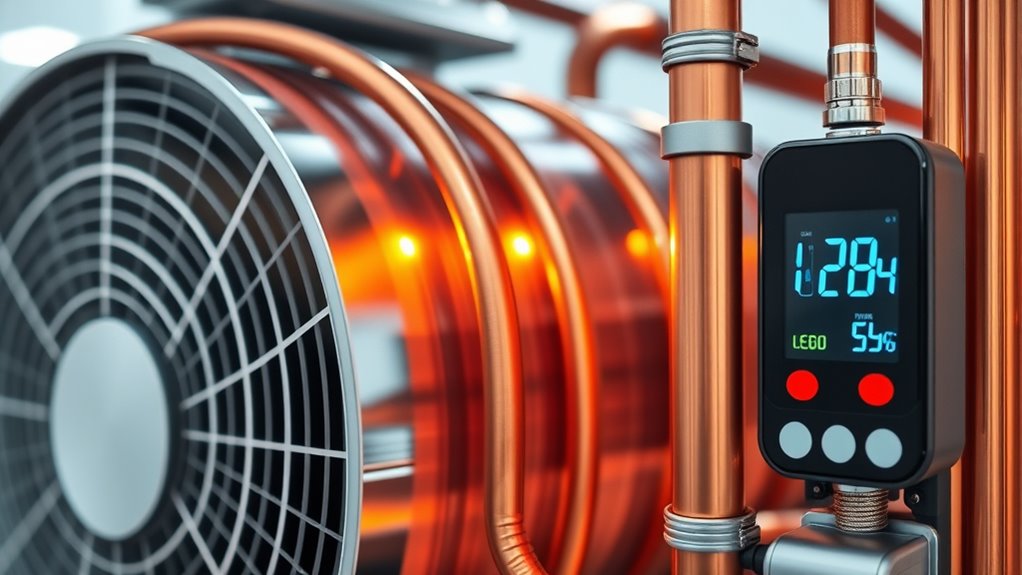
Innovative materials and techniques are transforming heat pump performance by considerably enhancing heat transfer efficiency. Here’s how:
- Nanofluids boost thermal conductivity in refrigerants, increasing heat transfer rates within heat exchangers.
- Phase Change Materials (PCMs) store and release thermal energy, stabilizing system performance during temperature fluctuations.
- Reflective and emissive coatings optimize radiative heat transfer by controlling surface emissivity and reducing heat losses.
- Smart, adaptive insulating materials allow real-time regulation of thermal properties, maximizing energy efficiency in varying conditions.
These advancements reduce energy consumption, improve system effectiveness, and enable more efficient thermal energy transfer. Incorporating nanotechnology-based heat exchangers and innovative insulating materials pushes heat pump technology toward higher performance and sustainability.
Frequently Asked Questions
How Does a Heat Pump Transfer Thermal Energy?
You might wonder how a heat pump moves thermal energy. It uses a refrigerant that absorbs heat when it evaporates and releases it when it condenses. The compressor boosts the refrigerant’s pressure and temperature, while the reversing valve switches between heating and cooling modes. As a result, heat is transferred from outside to inside or vice versa, making your space comfortable efficiently.
How Does Energy Exchange in a Heat Pump?
You ask how energy exchanges in a heat pump work. When you operate it, the refrigerant absorbs heat from a cold source like outside air or ground. The compressor then raises its pressure and temperature, moving the heat toward your indoor space. The reversing valve switches modes, allowing the system to heat or cool. This process follows thermodynamic principles, transferring energy efficiently through phase changes of the refrigerant.
What Are the 4 Types of Thermal Energy Transfer?
You’re curious about the four types of thermal energy transfer. Conduction occurs when heat moves through direct contact, with metals being quick transmitters. Convection involves currents in fluids like air or water carrying heat along. Radiation transfers heat via electromagnetic waves, even across vacuum spaces. Phase changes, like melting or boiling, allow heat absorption or release without changing temperature. These mechanisms work together to transfer thermal energy efficiently.
How Does Thermal Energy Transfer Work?
When you ask how thermal energy transfer works, think of heat moving from warmer to cooler areas through conduction, convection, and radiation. You can feel conduction when touching hot metal, convection as warm air rises, and radiation from the sun’s warmth. The transfer rate depends on material properties, temperature differences, surface area, and distance. You control this process in systems like heat pumps to efficiently transfer heat where needed.
Conclusion
Imagine a warm summer breeze or a cozy winter night, all powered by the silent dance of thermal energy within a heat pump. By understanding how heat moves through conduction, convection, and radiation, you can see how these systems efficiently warm your home or cool your space. With innovative materials and smart design, you’re harnessing nature’s energy flow—making comfort more sustainable and reliable. Embrace this invisible force, and let it transform your environment seamlessly.
